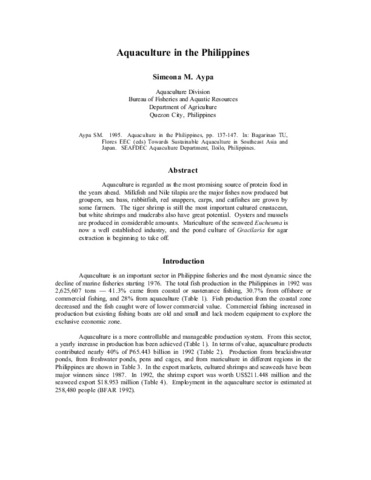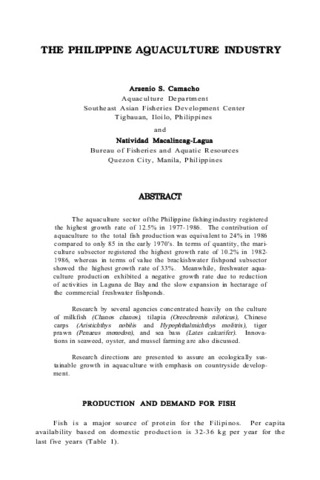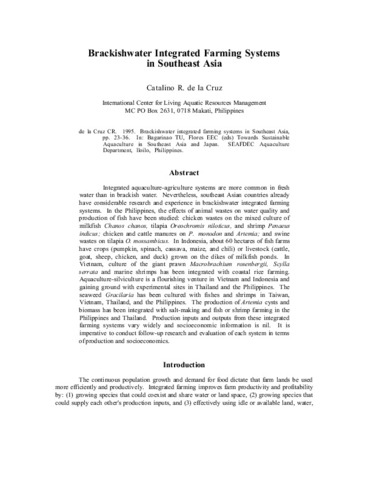| dc.contributor.author | Bonifacio, Maurino | |
| dc.contributor.editor | Quinitio, Emilia T. | |
| dc.contributor.editor | Parado-Estepa, Fe Dolores | |
| dc.contributor.editor | Coloso, Relicardo M. | |
| dc.date.accessioned | 2017-08-25T08:49:34Z | |
| dc.date.accessioned | 2017-08-25T16:38:21Z | |
| dc.date.available | 2017-08-25T08:49:34Z | |
| dc.date.available | 2017-08-25T16:38:21Z | |
| dc.date.issued | 2017 | |
| dc.identifier.citation | Bonifacio, M. (2017). Polyculture of mud crab in Region 3. In E. T. Quinitio, F. D. Parado-Estepa, & R. M. Coloso (Eds.), Philippines : In the forefront of the mud crab industry development : proceedings of the 1st National Mud Crab Congress, 16-18 November 2015, Iloilo City, Philippines (pp. 110-114). Tigbauan, Iloilo, Philippines: Aquaculture Department, Southeast Asian Fisheries Development Center. | en |
| dc.identifier.isbn | 9789719931072 | |
| dc.identifier.uri | http://hdl.handle.net/10862/3164 | |
| dc.description.abstract | The polyculture of mud crab with one to three other species (milkfish (Chanos chanos), tilapia (Oreochromis spp.) and shrimp or sugpo (Penaeus monodon)) is a common practice in Region 3. Pond preparation is given importance prior to stocking of various species. Removal of sludge in the pond and application of probiotics are included in the standard pond preparation. The size and stocking densities of each species vary depending on the season. The volume of water to be replaced is based on the transparency of the water.
The various species are fed natural food grown in the pond in addition to mollusks and low value fish given specifically for mud crab and shrimp. When pond water becomes transparent (indicating the decrease in phytoplankton density), the water is agitated using a small boat. If water continues to be transparent, fertilizers are applied to enhance growth of natural food. The pond water and animals are closely monitored to prevent diseases. Some of the early signs of occurrence of disease include the presence of bubbles on the water surface, and presence of weak shrimp on the feeding trays and along the dikes. The presence of weak shrimp and crab on the pond bottom and continuous swimming of these animals from night to dawn indicate poor pond water quality which can be remedied by circulating and flushing of the pond water every other day. | en |
| dc.language.iso | en | en |
| dc.publisher | Aquaculture Department, Southeast Asian Fisheries Development Center | en |
| dc.subject | Chanos chanos | en |
| dc.subject | Oreochromis | en |
| dc.subject | Penaeus monodon | en |
| dc.subject | Scylla | en |
| dc.subject | Philippines | en |
| dc.title | Polyculture of mud crab in Region 3 | en |
| dc.type | Conference paper | en |
| dc.citation.spage | 110 | |
| dc.citation.epage | 114 | |
| dc.subject.asfa | crab culture | en |
| dc.subject.asfa | cultured organisms | en |
| dc.subject.asfa | disease control | en |
| dc.subject.asfa | fish culture | en |
| dc.subject.asfa | marine crustaceans | en |
| dc.subject.asfa | phytoplankton | en |
| dc.subject.asfa | polyculture (aquaculture) | en |
| dc.subject.asfa | pond culture | en |
| dc.subject.asfa | ponds | en |
| dc.subject.asfa | shrimp culture | en |
| dc.subject.asfa | stocking density | en |
| dc.subject.asfa | water quality | en |
| dc.citation.conferenceTitle | Philippines : In the forefront of the mud crab industry development : proceedings of the 1st National Mud Crab Congress, 16-18 November 2015, Iloilo City, Philippines | en |
| dc.subject.scientificName | Penaeus monodon | en |
| dc.subject.scientificName | Chanos chanos | |



